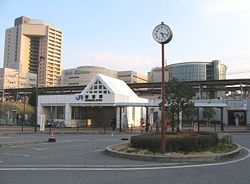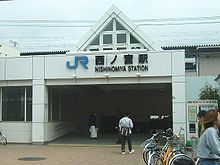- Nishinomiya Station (JR West)
-
Nishinomiya Station西宮駅

North entrance Location Prefecture Hyōgo
(See other stations in Hyōgo)City Nishinomiya Neighborhood etc. 9-3, Ikedacho Coordinates 34°44′19.55″N 135°20′52.32″E / 34.7387639°N 135.3478667°ECoordinates: 34°44′19.55″N 135°20′52.32″E / 34.7387639°N 135.3478667°E (in Japanese) 兵庫県西宮市池田町9-3 History Year opened 1874 Rail services Operator(s) JR West Line(s) Tōkaidō Main Line
(JR Kobe Line) Large bus terminal(s) attached to the station
Large bus terminal(s) attached to the stationNishinomiya Station (西宮駅 Nishinomiya-eki) is a train station located in Ikeda-chō (池田町), Nishinomiya, Hyōgo, Japan operated by the West Japan Railway Company (JR West). The station is on the JR Kobe Line which runs between Osaka Station and Himeji Station; part of the main Tōkaidō Line. As a part of the JR West Urban Network, the following cards are accepted: J-Thru Card, ICOCA, Suica, and PiTaPa.
Contents
Name
From 1874, when passenger service began at Nishinomiya Station, the name of the station was written as "西ノ宮". It included the katakana character "ノ" (no), which was not included in the city's name (西宮), to indicate the correct pronunciation of the station name. The city had been requesting that the "ノ" be removed to match the city's name. On March 18, 2007, in coordination with the opening of Sakura Shukugawa Station, the "ノ" was removed from the station name.
Layout and design
Station Placement
The section of the JR Kobe Line on which Nishinomiya is located runs on four tracks, meaning that there are two tracks for each direction. Similar to other nearby stations such as Sannomiya Station, Nishinomiya Station is of the island type, with two above-ground platforms which service four tracks. The inner tracks, Nos. 2 and 3, are for Local and Rapid Service trains, which do stop at this station. On the outside tracks, Nos. 1 and 4, Special Rapid Service and Limited Express trains pass and do not stop.
Gates
The station has two entrances that lead to an integrated ticket gate. The entrances are located on the north and south sides of the station. The gate is located one flight down from ground level. After passing through the gate, a passenger must take the stairs, escalator or elevator up to the platform.
Ticket office
The station has a Midori-no-Madoguchi, the JR ticket office equipped with MARS terminals. It is open everyday from 05:30 until 23:00.
Platforms
1 ■ JR Kobe Line
(Tōkaidō Line)rapid services for Sannomiya and Himeji in the rush hour on weekdays 2 ■ JR Kobe Line
(Tōkaidō Line)local trains and rapid services for Sannomiya and Himeji 3 ■ JR Kobe Line
(Tōkaidō Line)local trains and rapid services for Amagasaki, Ōsaka, Kyōto and Kitashinchi 4 ■ JR Kobe Line
(Tōkaidō Line)part of rapid services for Amagasaki, Ōsaka and Kyōto in the morning During rush hour, Track Nos. 1 and 4 are used for Rapid Service, while Local trains stop at Track Nos. 2 and 3. This allows people to transfer quickly from Local to Rapid Service trains, and allows the Rapid Service trains to pass ahead of the Local trains, which operate on the same track, unlike the Special Rapid Service and Limited Express trains. During the afternoon and night hours, when there is less traffic, Rapid Service trains stop at Track Nos. 2 and 3 only, and Track Nos. 1 and 4 are roped off as they are not in use.
Nishinomiya Station also has two short spurs that allow non-passenger trains (e.g. freight or maintenance) to stop and allow other traffic to pass.
Adjacent stations
« Service » JR Kōbe Line (Tōkaidō Main Line) Kōshienguchi Local Sakura Shukugawa Amagasaki Rapid Service Ashiya Special Rapid Service: no stop Area around the station
Inside the Station
- Daily-In
North Exit
- FamilyMart
- Nishinomiya Police Station
- Nishinomiya Shinmei Post Office
South Exit
- Route 2
- FamilyMart
- Frente Nishinomiya
- Nishinomiya Ekimae Post Office
- Nishinomiya Fire Station
Bus routes
Bus connections are available at the bus stops on the both side of the station.
North exit
- Platform 1
-
- Hankyu Bus
- Nishinomiya City Route for Nishinomiya-Kitaguchi and Kōtōen
- Hanshin Bus
- Nishinomiya-Kitaguchi Route for Nishinomiya-Kitaguchi
- Nishinomiya Yamate Loop for Koyoen
- Jūrinji Loop for Jūrinji
- Platform 2
-
- Hankyu Bus
- Nishinomiya City Route for Nishinomiya City Hall, Hanshin Nishinomiya and Asanagicho
- Hanshin Bus
- Nishinomiya-Kitaguchi Route, Nishinomiya Yamate Loop, Jūrinji Loop for Hanshin Nishinomiya
- Platform 3
-
- Hankyu Bus
- Sakura Yamanami Bus for Nishinomiyaebisu Sakura Shukugawa, Hankyu Shukugawa, Arima Onsen, Ryutsu Center minami and Hankyu Bus Yamaguchi Office
- Platform 4
-
- Hankyu Bus
- Sakura Yamanami Bus for Nishinomiya-Kitaguchi
South exit
- Airport Limousine
-
- Hankyu Bus, Hanshin Bus, Osaka Airport Transport, Kansai Airport Transportation Enterprise, Nankai Bus
- Platform 2
-
- Hanshin Bus
- Amagasaki Ashiya Route for Hanshin Amagasaki
- Nishinomiya Amagasaki Route for Hanshin Koshien and Hanshin Amagasaki
- Nishinomiya Danchi Route for Hanshin Koshien and Hamakoshien Danchi
- Nishinomiya Hamate Route for Nishinomiya-Kitaguchi
- Platform 3
-
- Hanshin Bus
- Nishinomiya Hamate Route for Hanshin Nishinomiya and Marina Park
- Amagasaki Ashiya Route for Hanshin Ashiya
History
Timeline
- May 11, 1874 - Station opens for passenger service with the name 西ノ宮駅 at the same time rail service begins between Osaka Station and Kobe Station.
- November 15, 1944 - Hanshin Mukogawa Line operating between Nishinomiya Station and Suzaki Station begins freight service.
- 1958 - Hanshin Mukogawa Line between Nishinomiya Station and Suzaki Station ceases operation. Later, in 1970, the rail line was pulled up.
- November 1, 1986 - Freight handling ceases.
- East of Nishinomiya Station is the Asahi Beer Nishinomiya Brewery and even further east is Sumitomo Cement Service Station. There was a private line running to both of these places which handled freight.
- April 1, 1987 - With the breaking up of Japanese National Railways into separate individual business units, Nishinomiya Station began operating under the West Japan Railway Company.
- December 1, 2003 - Rapid Service trains begin continuous service to Nishinomiya Station. Until this time, Rapid Service trains only stopped during morning and evening rush hour.
- March 18, 2007 - Station renamed 西宮駅 in coordination with the opening of Sakura Shukugawa Station.
Beginning
Originally built around Nishinomiya Jinja as an inn town for travelers going further west and for those going to the east and central parts of Japan, beginning in the Edo period, Nishinomiya flourished as an important trading port and fishing harbor, and because the population was large, a train station was placed there. Originally, it is said, that a Katakana character "ノ" was inserted into the station's name in accordance with the policy of the government railway because people from Tokyo could not read the names correctly. In the same way, a "ノ" was inserted to the name of JR Sannomiya Station (三ノ宮駅), which opened on the same day as Nishinomiya Station. However, truth behind this is not clearly known. The national railways later scrapped this naming method; for example, it named Nishinomiya Najio Station on the Fukuchiyama Line without a "ノ" in 1986.
Unlike Hanshin Electric Railway, which was built after the opening of JR Nishinomiya and ran directly between Osaka and Kobe, at the time passenger service began, JR Nishinomiya Station was built away from the city's center in a slightly agricultural area. The rail that passed through divided the city north and south, it is said that this caused the flow of people to begin moving east and west.
Competitor stations
Later, after the construction of the Tōkaidō Main Line through to Kobe, Hanshin Electric Railway and Hankyu Railway each built their own lines connecting Osaka to Kobe. In the same area as JR Nishinomiya Station, Hanshin Nishinomiya Station and Hankyū Nishinomiya-Kitaguchi Station were built, which decentralized rail service in Nishinomiya, and provided customers other rail service options.
In 1934, the government railways built Kōshienguchi Station adjacent to Nishinomiya Station. The number of passengers using Kōshienguchi Station quickly exceeded that of Nishinomiya Station. During era of Japanese National Railways, that number was approximately double.[clarification needed]
Rapid service
In 1957, a study was conducted to find a station that would be suitable as a Rapid Service stop.[citation needed] An argument unfolded between the adjacent Ashiya Station and Nishinomiya Station.[clarification needed] In the end, it was decided that Rapid Service trains running on the inner tracks of the four track line, the Local service tracks, would stop at Ashiya Station. The Rapid Service trains operating on the two outer tracks would stop at Nishinomiya Station. However, in 2003, it was decided that all Local and Rapid Service trains would stop at both stations.
With the area around the station quickly becoming developed, and with the aforementioned fact that all Rapid Service trains stop at Nishinomiya Station, the difference between the number of passengers using Nishinomiya Station and Kōshienguchi Station suddenly began shrinking.
Renaming
On March 18, 2007, in coordination with the beginning of passenger service at Sakura Shukugawa Station, at the request of the city, the "ノ" was removed from the station's name and renamed 西宮駅 while the "ノ" in the name of JR Sannomiya Station was retained.
Streetcar connection
From 1926 to 1975, on the Route 2, which passes in front of the station, there used to be an inner-city street car which shared the road with other vehicle traffic.
The closest street car stop to the Nishinomiya Station was named Nishinomiya Ekimae (西宮駅前).
Bus connection
After Hanshin Electric Railway ceased the street car service, the Amagasaki-Kobe Line of Hanshin Railway Bus replaced it. At the south exit to the station, a roundabout was built, and the Nishinomiya Ekimae bus stop was moved to this location and renamed to Kokudō JR Nishinomiya Eki Mae (国道JR西宮駅前).[when?] In addition, on the inside of the roundabout, another bus stop was established with the name JR Nishinomiya Ekimae (JR西宮駅前), allowing busses running in both directions to be able to line up outside the station at one place. In either case, both bus stops were called Nishinomiya Ekimae (西宮駅前), without the "ノ" even during the time when the station name itself was written with it.
External links
- Ekikara - JR Nishinomiya Station (Japanese)
- JR Odekake - Nishinomiya Station (Japanese)
Stations of the JR West JR Kobe Line (Tōkaidō Main Line • Sanyō Main Line) (JR Kyōto Line <<) Ōsaka - Tsukamoto - (JR Tozai Line<<) Amagasaki - Tachibana - Kōshienguchi - Nishinomiya - Sakura Shukugawa - Ashiya - Kōnan-Yamate - Settsu-Motoyama - Sumiyoshi - Rokkōmichi - (Higashinada Signal Box) - Nada - Sannomiya - Motomachi - Kōbe - Hyōgo - Shin-Nagata - Takatori (Kōbe Freight Terminal) - Sumakaihinkōen - Suma - Shioya - Tarumi- Maiko - Asagiri - Akashi - Nishi-Akashi - Ōkubo - Uozumi - Tsuchiyama - Higashi-Kakogawa - Kakogawa - Hōden - Sone - Himeji-Bessho (Himeji Freight) - Gochaku - Himeji (>> Sanyō Main Line for Kamigori and Banshu-Ako)
Wadamisaki Line: Hyōgo - Wadamisaki
Freight Branch Line (Abandoned Section in 1980) : Amagasaki - Amagasakishijō / Freight Branch Line (Abandoned Section in 1979) : Himeji - HimejishijōCategories:- Railway stations in Hyōgo Prefecture
- Railway stations opened in 1874
- Stations of West Japan Railway Company
- Tōkaidō Main Line
- Kōbe Line
Wikimedia Foundation. 2010.

